Managing Salary Band Structures: A Comprehensive Guide
Explore how salary band structures ensure fair pay, attract talent, and support career progression with effective management and strategic best practices.

You’ve just been tasked with refining your company’s salary band structure, but where do you begin? For many HRBPs and finance teams, salary bands seem simple until it’s time to create a system that’s both fair and competitive.
It’s not just about setting pay ranges; it’s about creating a framework that balances employee expectations, company goals, and the evolving job market.
To help you better prepare for these challenges, this guide teaches you how to design salary bands that ensure fairness, align with business goals, and ultimately improve retention.
TL;DR
- Salary bands define the pay range for job roles, ensuring fairness and consistency in compensation.
- They support pay transparency, clarify career band progression, and help with attracting and retaining talent.
- Managing salary bands requires regular updates, market adjustments, and clear communication for effectiveness.
- Creating an effective salary band structure involves defining job levels, conducting market research, and establishing clear pay ranges for each role.
- Common challenges in salary band management include maintaining pay equity, adjusting for market changes, and ensuring clarity in communication, which can be managed with the right tools.
What Are Salary Bands?
Salary bands are structured ranges that define the minimum and maximum salary for a specific role or job level within a company.
The purpose of salary bands is to ensure employees in similar roles or job levels are compensated equitably, taking into account factors such as experience, skills, responsibilities, and market conditions.
Salary Bands vs. Other Pay Structures
To understand how salary bands compare to other pay structures, let’s break down the key differences and provide real-world examples for each:
A software engineer’s salary is set based on the 75th percentile of market data ($70,000 - $90,000), but offers little room for progression within the same band without changing roles.
The next step is to understand the key elements that make up an effective salary band structure.

The Key Elements of a Salary Band Structure
To create a well-structured salary band system, you must understand the various components that contribute to its success.
Job Classification
Job classification is the foundation for organizing employees into different salary bands based on their roles, experience, and responsibilities.
- Job roles are grouped based on their complexity, skill requirements, and the level of experience needed. For example, an entry-level software developer might be classified under salary band 1. In contrast, a senior developer could be placed in salary band 4, based on their level of responsibility and experience.
- It helps in defining clear career progression paths within the company. Employees can see a clear path for salary increases as they assume additional responsibilities.
Pay Range Structure
The pay range structure is what defines the minimum, midpoint, and maximum salaries within each salary band. Understanding this structure is key to ensuring fair and competitive pay.
- Minimum Salary: The starting point for a role, based on entry-level experience or market demand. This sets a baseline for new employees in the role.
- Midpoint Salary: Typically aligned with market trends, this is the competitive market value for a given role. It’s often used as a benchmark to assess salary impartiality.
- Maximum Salary: The highest pay possible within a band, reflecting the top performance or highest level of experience for that role. It provides employees with long-term growth opportunities without moving into a different job level.
Internal vs. External Considerations
Balancing internal company factors and external market conditions is essential for developing a realistic and competitive salary band structure.
- Internal Factors: These include company budgets, internal pay equity, and employee performance. Setting salary bands within these limits ensures that the company remains financially viable and can manage salary increases effectively.
- External Factors: External factors, such as market pay surveys, competitor pay practices, and industry benchmarks, help ensure that the company's pay scales are competitive. Regularly reviewing these data points ensures your salary bands remain aligned with current industry standards.
The key elements of salary bands lay the groundwork for understanding why these structures are essential for business success.
Why Salary Bands Matter: The Strategic Benefits
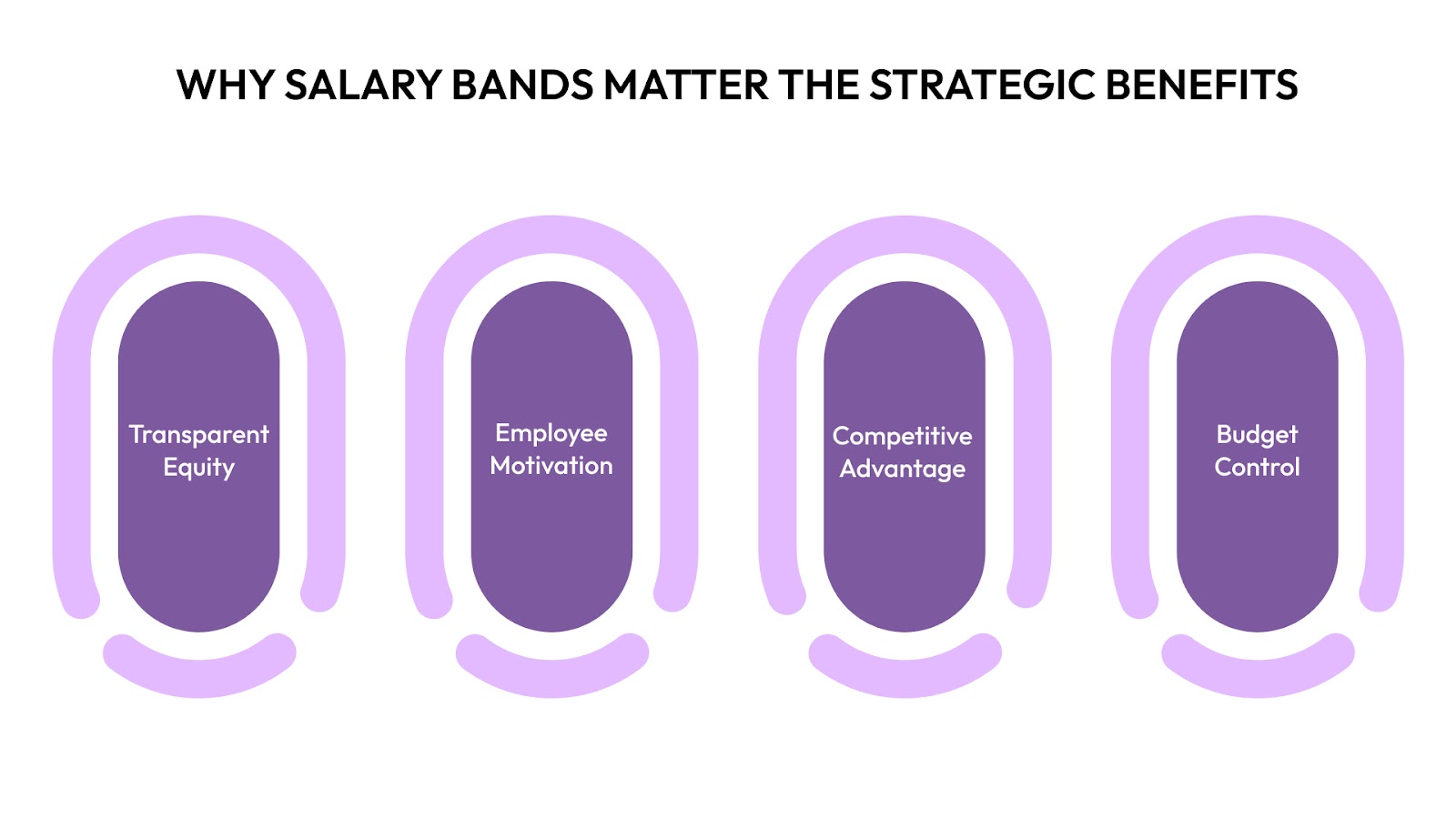
Salary bands don’t just determine pay; they also serve multiple strategic purposes for both employees and the organization.
1. Fairness and Transparency
By establishing clear salary ranges for all job levels, salary bands help ensure that employees are compensated fairly, based on their role and responsibilities.
2. Employee Motivation and Retention
Salary bands offer employees a transparent career progression path, motivating them to reach the next level and boosting overall retention by showing a clear connection between performance and pay.
3. Competitive Advantage
By aligning salary bands with market data, organizations can attract top talent while keeping current employees engaged, ensuring competitive compensation across the industry.
4. Budget Control
With predefined salary bands, organizations can more accurately forecast payroll expenses and maintain control over compensation budgets, reducing the risk of exceeding financial limits.
Building a salary band structure that delivers these benefits requires a thoughtful approach to design and implementation. Let’s look at the steps to create the right structure for your organization.
How to Create an Effective Salary Band Structure
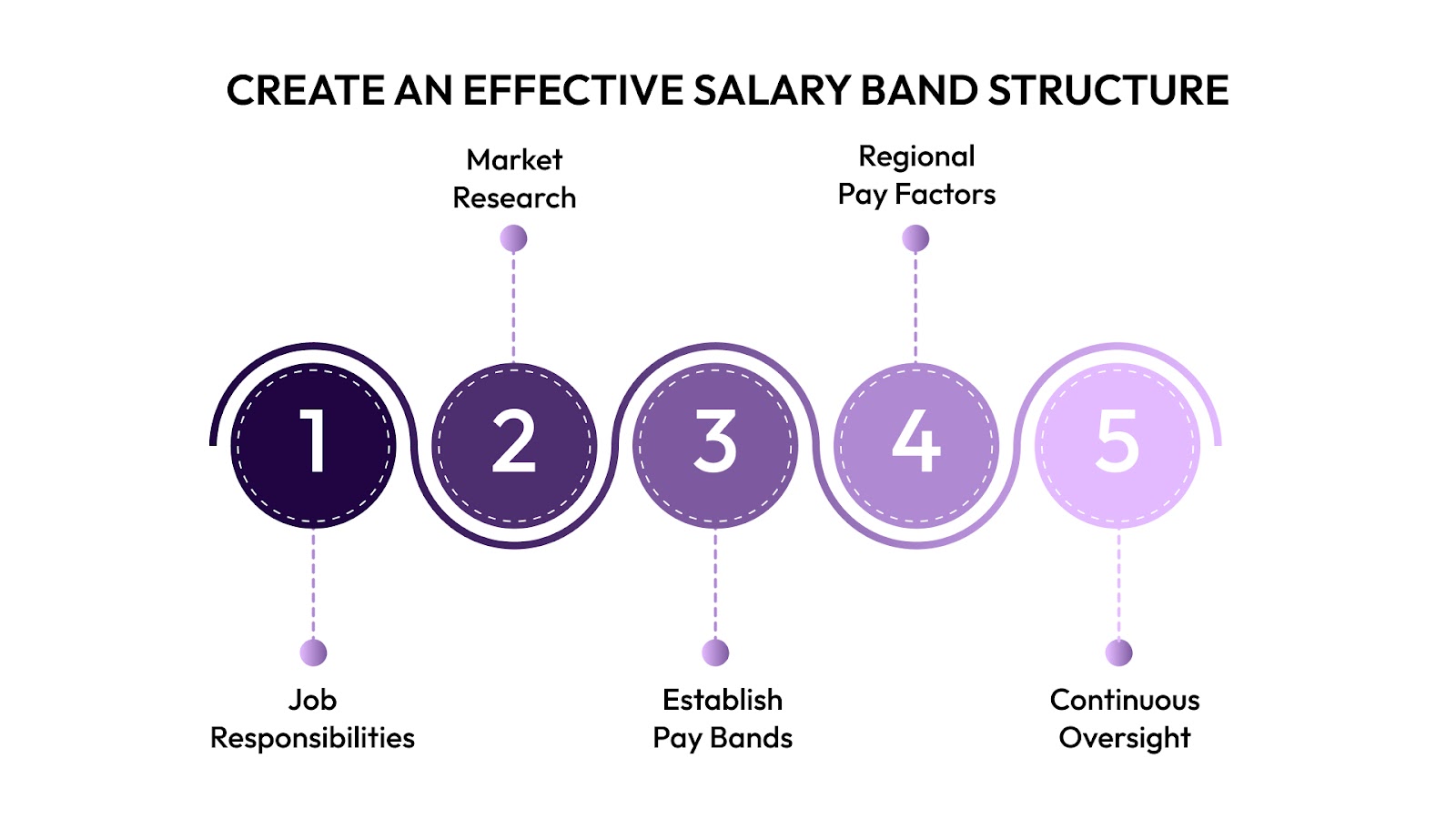
To help you build an effective salary band structure that aligns with your organizational needs, here’s a step-by-step guide.
Step 1: Define Job Levels and Responsibilities
The first step is to classify each role based on its level of responsibility, required experience, and complexity. This ensures that each role is paired with an appropriate salary band.
- Categorize roles by their core responsibilities, such as entry-level, mid-level, and senior positions.
- Define clear responsibilities and skills required for each job level to ensure accuracy in classification.
- Ensure the salary bands reflect the level of responsibility and contribution to the organization, providing room for career growth.
Step 2: Conduct Market Research
Next, gather competitive data from trusted sources to inform the midpoint for your salary bands. This research helps ensure that your salary bands remain competitive and in line with current market trends.
- Use up-to-date salary surveys, industry reports, and government data sources (e.g., U.S. Bureau of Labor Statistics) to identify market rates for similar roles.
- Ensure the data reflects the location, job sector, and company size to maintain relevance.
- Use the market research to determine a competitive midpoint for each salary band and adjust accordingly for seniority and specialization.
Step 3: Establish Pay Range for Each Role
Once you have the necessary data, the next step is to set the salary range for each job level or band. This range should provide sufficient flexibility for employee growth while maintaining equity within the company.
- Set minimum, midpoint, and maximum salary levels that reflect the employee’s experience, qualifications, and contribution to the company.
- Ensure the pay range provides opportunities for progression and raises within the band before the employee moves up to the next level.
- Adjust the range periodically based on market trends, internal pay equity, and company performance.
Step 4: Factor in Geographic Differences
Geographic location can significantly impact salary ranges, especially in a global or remote workforce. Adjusting salary bands to account for geographical differences ensures that employees are fairly compensated based on their location.
- Research regional cost-of-living data to ensure salary ranges reflect the local market.
- For global companies, create separate salary bands for different geographic areas or regions to maintain consistency and transparency.
- Consider location-based pay scales when hiring remote workers to ensure competitive compensation.
Step 5: Continuous Monitoring and Adjustments
Salary bands should not be static; they must be regularly reviewed and adjusted to keep up with market trends, internal shifts, and employee expectations.
- Set a regular schedule for revisiting salary bands to ensure they remain competitive and aligned with the market.
- Collect employee feedback on pay structures to gauge satisfaction and address concerns.
- Stay proactive in adjusting salary bands to account for changes in the economy, company growth, or shifting market dynamics.
Now, as you begin building your salary band structure, it's important to understand the challenges that can arise and how to address them effectively.

Challenges with Salary Bands and How CandorIQ Helps Overcome Them
Managing salary bands effectively comes with its own set of challenges. Below, we highlight some of the most common obstacles faced by HR teams and how CandorIQ provides targeted solutions.
1. Challenge: Maintaining Pay Equity Across Job Roles and Locations
Ensuring pay equity within salary bands can be difficult, especially in organizations with diverse job roles and locations. It can become complex to monitor pay disparities and adjust salary bands consistently without causing confusion or dissatisfaction.
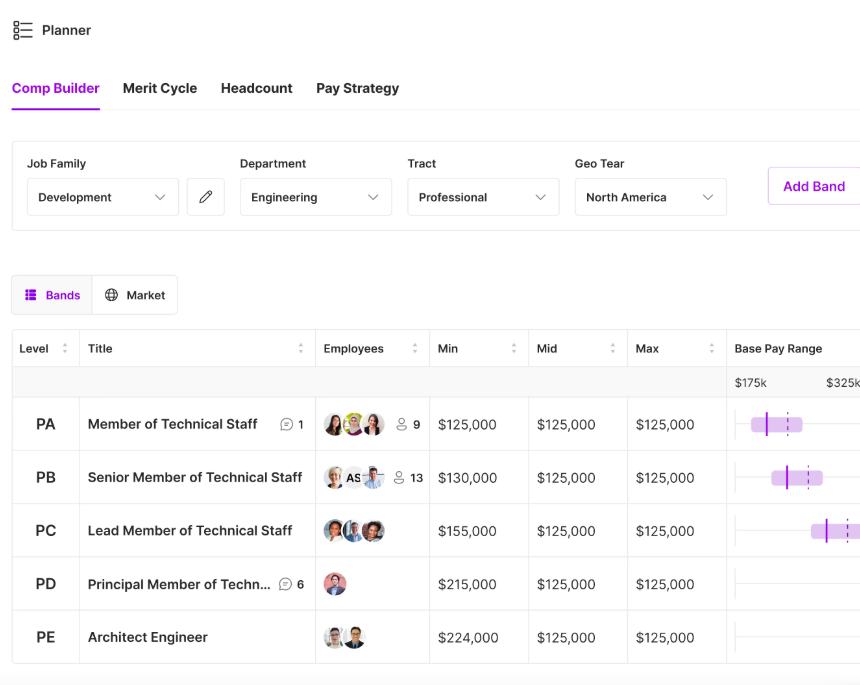
CandorIQ Solution:
- Compensation & Payband Builder: Define pay bands by role, location, and department.
- Apply location-based salary adjustments using real-time benchmark datasets.
- Track salary distribution across your workforce to monitor and ensure pay equity.
- Improve transparency and reduce discrepancies in compensation.
2. Challenge: Managing and Updating Salary Bands Efficiently
As companies grow and market conditions evolve, salary bands need to be frequently updated. Manually adjusting salary bands can be time-consuming and error-prone, particularly when trying to align with shifting market trends and internal company goals.
CandorIQ Solution:
- Real-Time Collaboration: Stay up-to-date with salary band updates and make adjustments based on real-time data.
- Version Control: Track historical band changes to ensure that salary bands are always aligned with current market standards and internal needs.
- Eliminate the need for spreadsheets, reducing manual labor and errors in salary band management.
3. Challenge: Aligning Compensation with Company Goals and Budgets
It’s critical to ensure that salary bands reflect market competitiveness while staying within the company’s financial capabilities.

CandorIQ Solution:
- Headcount Scenario Planning: Simulate various workforce scenarios and forecast the financial impact of different salary bands.
- Ensure compensation decisions align with strategic hiring goals and available budgets.
- Make data-driven decisions to stay within budget while offering competitive pay.
4. Challenge: Ensuring Accurate Salary Band Calculations for Promotions and New Hires
Incorrect salary band decisions can lead to overpaying or underpaying employees, causing dissatisfaction and potential turnover.
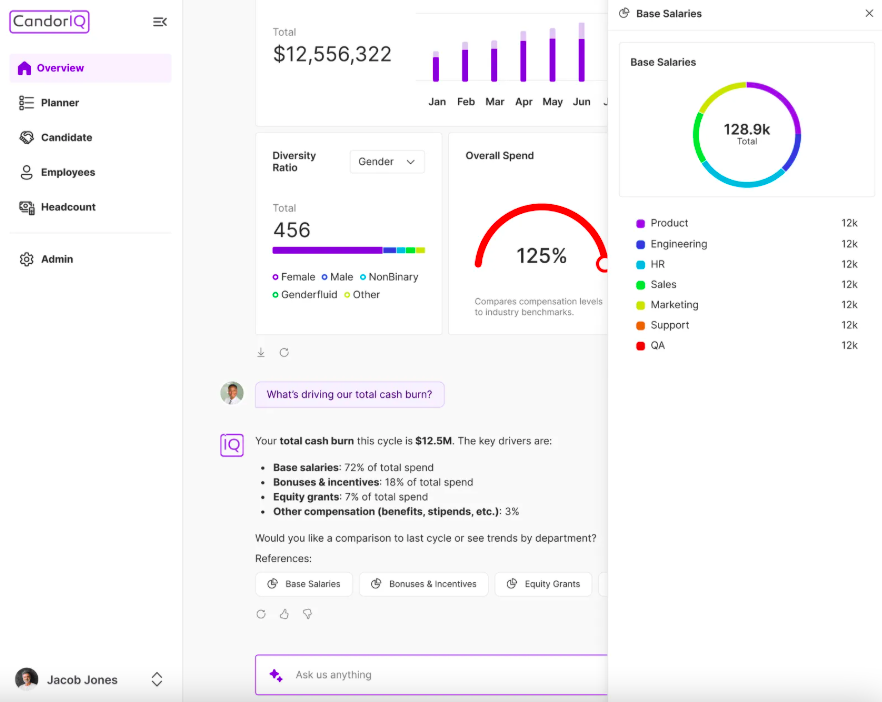
CandorIQ Solution:
- AI-Driven Insights: Use historical benchmarks and peer data to provide precise compensation recommendations for new hires and promotions.
- Optimize salary band calculations based on market expectations and internal goals.
- Reduce guesswork in salary decisions and ensure fair and competitive compensation.
With CandorIQ’s solutions optimizing the process, let’s see some additional practices that can help you manage salary band structure.
Best Practices for Effective Salary Band Management
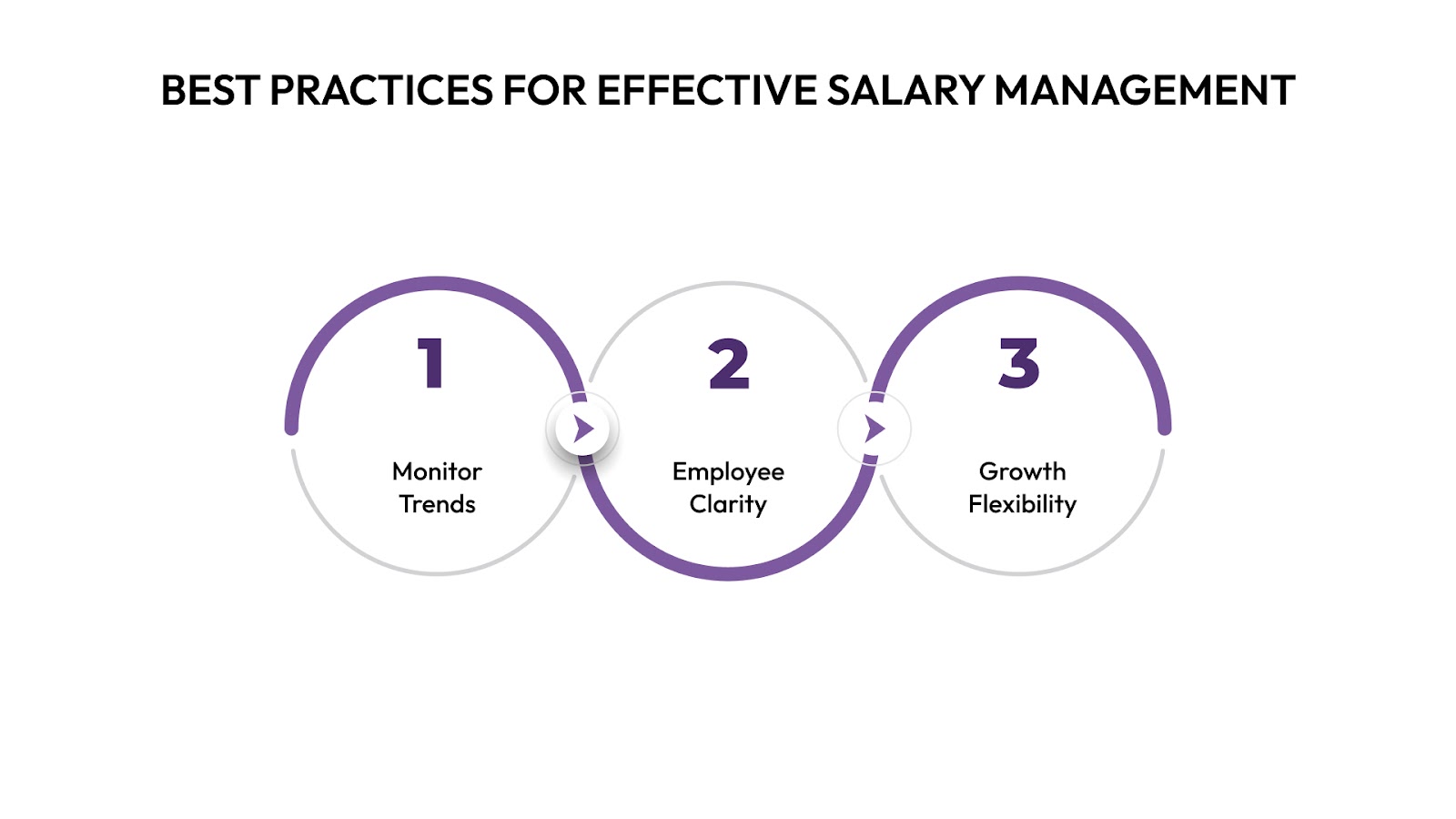
To effectively manage salary bands, you need to follow certain practices.
1. Monitor Market Trends Regularly
Continuously review industry salary surveys, benchmark data, and market reports to ensure that salary bands accurately reflect current compensation trends and remain competitive in attracting top talent.
2. Clear Communication with Employees
Transparently communicate the structure and purpose of salary bands to employees. Clarify how they can progress within their bands and the criteria for advancement, building a sense of fairness and clarity.
3. Ensure Flexibility for Employee Growth
Design salary bands with room for growth, allowing employees to progress as they gain experience and improve their performance. Establish clear, measurable milestones for transitioning between salary levels.
By using CandorIQ’s solutions and following these best practices, you can ensure that your salary band structure supports both fair compensation and long-term employee growth.
Key Takeaways
Managing salary bands can be a difficult task, especially when trying to maintain fairness, competitiveness, and stay within budget.
CandorIQ makes this easier for mid-sized to growth-stage organizations scaling rapidly with lean HR and finance teams. It consolidates multiple tools into a unified system for managing pay bands, compensation cycles, headcount forecasting, and offer workflows.
With tools like the Compensation & Payband Builder and real-time insights, CandorIQ helps you manage salary bands effectively and align them with your goals.
Ready to simplify your salary band management? Book a demo with CandorIQ today!

FAQs
Q1. How are salary bands different from job bands?
A1. Salary bands focus on defining pay ranges for specific roles or job levels, while job bands refer to the classification of job roles based on responsibility and experience. Job bands help group similar roles, while salary bands determine the compensation for employees in those roles.
Q2. How often should salary bands be reviewed?
A2. Salary bands should be reviewed at least annually to ensure they remain competitive with market trends. Regular reviews help adjust for changes in job responsibilities, inflation, and market conditions, ensuring transparency and competitiveness.
Q3. What is the purpose of having a salary band structure?
A3. A salary band structure ensures pay consistency across roles, allowing for clear career progression. It also helps with budgeting, salary planning, and attracting top talent by offering transparent pay ranges.
Q4. How do career bands work in salary band structures?
A4. Career bands define the different levels of responsibility and growth within a job role. Employees progress through career bands by meeting performance goals, gaining experience, and advancing in responsibility, with corresponding salary increases within the assigned band.
Q5. Can salary bands be adjusted for remote employees?
A5. Yes, salary bands can be adjusted for remote employees based on geographic location. Companies can apply location-based salary adjustments to account for varying costs of living in different regions, ensuring fair compensation across their global workforce.


